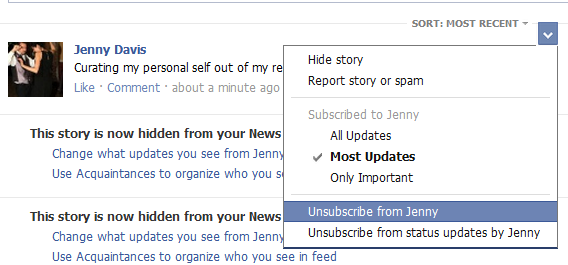Several weeks ago, I wrote a post about how we not only manage our image (outgoing) but also curate our view (incoming). As a very brief summary, I argued, based upon data from my own ongoing social media study, that despite the potential for social media to expose us to a variety of perspectives and opinions (creating a public sphere, or at least a public space), we discriminately select which perspectives and opinions to let in, and which to exclude. In doing so, we curate reality. Though this manifests in a variety of ways, a prevalent manifestation is the management of one’s Facebook News Feed.
A new push for the (apparently long present) feature on Facebook, in which users are asked to “star” the Friends whose content they want to make more visible, further supports this trend. More importantly, however, it demonstrates the mutually influential relationship between physical architectures, normative social structures, and personal practices.
The physical architecture of a space (online or offline) simultaneously shapes, and is shaped by, those who use it. For instance, the typical classroom is set up with an instructor who stands at a high desk in the front of a room, facing students, who sit in low desks, with their bodies and eyes oriented forwards and upwards towards the teacher. This both creates and reflects a particular power dynamic, and guides how participants in the interaction think about and act towards themselves and one another. Similarly, architectures of online spaces reflect and guide who we are and what we do in those spaces.
Although one effective—and indeed widely practiced—way to curate reality on social media is through limiting connections (i.e. refusing Friend requests and Unfriending), there are both architectural and normative obstacles to this practice. Architecturally, the Terms of Service “require” that users go by a real name, making people easily findable through the (architecturally provided) “search” feature. Normatively, users expect their Friend requests to be accepted, and the severance of a Facebook connection holds tangible relational consequences.
“Hiding” a Friend’s posts is far less contentious. This feature has been available for some time on Facebook, but the management of posts continues to progress. With the advent of Timeline, users were offered a nuanced management tool attached to each of their Friend’s posts (see pic below).

Here, one can selectively highlight, limit, or exclude completely the content produced by particular Friends. This architectural feature promotes the practice of reality curation.
In turn, the proliferation of this practice promotes architectural adjustments. In this case, the architectural adjustment (and Facebook’s commercial push for awareness and utilization of the this adjustment) is that of “starring.” Future architectural changes will be inevitably imbued with the manner and extent to which users utilize this and other features.

